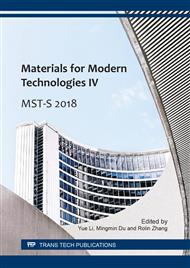[1]
L. Z. Cheng, Applications of carbon fiber composites, Advanced Materials Research 378-379 (2011) 121-124.
Google Scholar
[2]
F. Ahmad, H.S. Choi, M.K. Park, A review: natural fiber composites selection in view of mechanical, lightweight, and economic properties, Macromolecular Materials & Engineering 300 (2015) 10-24.
DOI: 10.1002/mame.201400089
Google Scholar
[3]
C. Red, Automotive CFRP: The shape of things to come, Composites Technology 18 (2013) 30-35.
Google Scholar
[4]
C. Kong, H. Lee, H. Park, Design and manufacturing of automobile hood using natural composite structure, Composites Part B 91 (2016) 18-26.
DOI: 10.1016/j.compositesb.2015.12.033
Google Scholar
[5]
G. Fu, H. Philip, N.J. Miles, Development of composites based on recycled polypropylene for injection moulding automobile parts using hierarchical clustering analysis and principal component estimate, Journal of Cleaner Production 137 (2016).
DOI: 10.1016/j.jclepro.2016.07.028
Google Scholar
[6]
T.T. Deng, D.J. Nelson, Bus Rapid Transit implementation in Beijing: An evaluation of performance and impacts, Research in Transportation Economics 39 (2013) 108-113.
DOI: 10.1016/j.retrec.2012.06.002
Google Scholar
[7]
T. Satiennam, S. Jaensirisak, W. Satiennam etc, Potential for modal shift by passenger car and motorcycle users towards Bus Rapid Transit (BRT) in an Asian developing city, IATSS Research 39 (2016) 121-129.
DOI: 10.1016/j.iatssr.2015.03.002
Google Scholar
[8]
T.T. Deng, D.J. Nelson, Recent developments in Bus Rapid Transit: A review of the literature, Transport Reviews 31 (2011) 69-96.
DOI: 10.1080/01441647.2010.492455
Google Scholar
[9]
D. Croccolo, M. de Agostinis, N. Vincenzi, Structural analysis of an articulated urban bus chassis via FEM: a methodology applied to a case study, Journal of Mechanical Engineering 57 (2011) 799-809.
DOI: 10.5545/sv-jme.2011.077
Google Scholar
[10]
M. Hjort, T. Fälth, Joint for joining a first car and a second car of a multi-car vehicle and multi-car vehicle, European Patent 2,692,555. (2014).
Google Scholar
[11]
R. Ahrens, J.H. Dicke, U. Bittroff etc, Articulated vehicle with a joint between the vehicle parts, U.S. Patent 9,132,860. (2015).
Google Scholar


